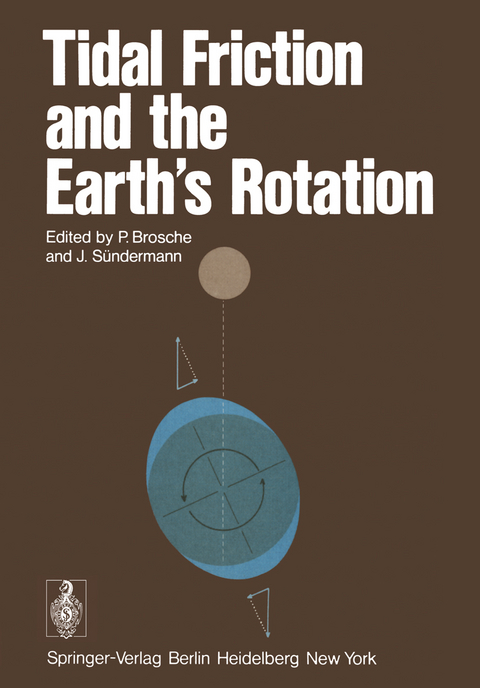
Tidal Friction and the Earth’s Rotation
Springer Berlin (Verlag)
978-3-540-09046-5 (ISBN)
Historical Background and Introduction.- References.- Pre-Telescopic Astronomical Observations.- 1. Introduction.- 2. Historical Development.- 3. Inter-Relation of Parameters.- 4. Recent Investigations.- 5. Remarks on the Selection of Suitable Observations.- 6. Observations of Total and Near-Total Solar Eclipses.- 7. Method of Analysis.- 8. Geophysical Discussion.- 9. Conclusions.- References.- Tidal Deceleration of the Earth's Rotation Deduced from Astronomical bservations in the Period A.D. 1600 to the Present.- 1. Introduction and Principle of Method.- 2. Moon's Orbital Angular Deceleration.- 2.1 Deceleration with Respect to Dynamical Time.- 2.2 Deceleration with Respect to Atomic Time.- 3. Tidal Deceleration of Earth's Rotation.- 4. Conclusions.- References.- Determination of the Rotation of the Earth (at Present).- 1. Introduction.- 1.1 Preview.- 2. General Features of the Rotation of the Earth.- 2.1 Variation in the Earth's Rate of Rotation.- 2.2 Polar Motion.- 3. Equatorial System.- 4. Astronomic Longitude and Latitude.- 5. Time Scales.- 5.1 Astronomic Time.- 5.2 Atomic Time.- 6. Methods and Instruments of Observation.- 6.1 Optical Instruments.- 6.2 Doppler Satellite Measurements.- 7. Data Analysis Centers.- 8. Results on the Rotation of the Earth.- References.- Effect of Tidal Friction on the Lunar Orbit and the Rotation of Earth and Its Determination by Laser Ranging.- 1. Introduction.- 2. The Physical Problem.- 3. The Laser Technique and Its Application.- 4. Determination of the Lunar Acceleration.- 5. Comparisons and Difficulties of Interpretation.- References.- Appendix A: Comments on the Perturbed Mean Motion 52 ppendix B: Reality of the Venus Effect 53 ides of the Solid Earth from Gravimetric Measurements.- 1. Introduction.- 2. Basic Concepts.-3. The Tidal Potential.- 4. Determination of LOVE numbers from Gravimetric Data.- 5. Instrumentation.- 6. Actual Problems.- 7. Recent Results.- 8. Future Activities.- References.- Tidal Friction in the Solid Earth: Loading Tides Versus Body Tides.- 1. Introduction.- 2. Dissipated Tidal Energy in the Solid Earth.- 2.1 Theory of Dissipation in a Heterogeneous Incompressible Earth.- 2.2 Dissipation of Body Tide Energy.- 2.3 Dissipation of Loading Tide Energy.- 3. Global Tidal Q and Tidal Phase Shifts.- 3.1 Loading Tide Q Versus Body Tide Q.- 3.2 Numerical Results for the Body Tide.- 3.3 Theoretical Relationship between Tidal Bulge Angles, Body Tide Phase Shifts, and the Global Body Tide Q.- 3.4 Some More Numerical Examples.- 3.5 Numerical Results for the Loading Tides.- 4. Conclusions.- References.- Tidal Dissipation in the Oceans.- References.- The Influence of Solid Earth Deformations on Semidiurnal and iurnal Oceanic Tides.- 1. Introduction.- 2. Considering Tidal Loading and Ocean Self-Attraction in.- Ocean-Tide Models.- 2.1 Tidal Integrodifferential Equations and the Energy-Equation Belonging to Them.- 2.2 Properties of Different Ocean-Tide Models.- 3. Generalization of the 4°-Primitive-Equations Model.- 3.1 The Finite-Difference Scheme.- 3.2 Oceanic Tides on a Nonrotating Earth.- 4. The Computed Global M2-Tide.- 5. The Computed Global K1-Tide.- 6. Conclusions.- Glossary of Symbols.- References.- The Numerical Computation of Tidal Friction for Present and ncient Oceans.- 1. Introduction.- 2. Computation of Tidal Friction by Hydrodynamic-Numerical.- Models.- 2.1 Basic Equations.- 2.2 Analytic Considerations.- 2.3 Hydrodynamic-Numerical Models.- 3. A Numerical Model for the Present Ocean.- 3.1 Requirements.- 3.2 Balance of Angular Momentum.- 4. Numerical Model forAncient Oceans.- 4.1 Necessity of Such a Model.- 4.2 Bathymetry.- 4.3 Application to the Permian Ocean.- 4.4 Verification.- 5. Further Activities.- References.- The Earth's Palaeorotation.- 1. The Coral Data.- 2. The Bivalve Data.- 3. Stromatolite Data.- 4. Combined Data 1.- References.- Periodic Growth Features in Fossil Organisms and the Lenght of the ay and Month.- 1. Introduction.- 2. Biological Considerations.- 2.1 Growth Increments in Corals.- 2.2 Growth Increments in Bivalves.- 2.3 Growth Increments in Stromatolites.- 2.4 Biological Clocks.- 3. The Data.- 3.1 Recording the Data.- 3.2 The Published Data.- 4. Implications of the Growth Increment Data.- 5. Conclusions.- References.- Geological and Geophysical Evidence Relating to Continental rowth and Dynamics and the Hydrosphere in Precambrian Times: Review and Analysis.- 1. Introduction.- 2. The Hydrosphere.- 3. The Continental Crust.- 4. Precambrian Dynamics of the Continental Crust.- 5. Palaeomagnetic Analysis of Precambrian Crustal Movements.- 5.1 Gondwanaland-Late Precambrian and Lower Palaeozoic.- 5.2 Laurentian Shield-Upper Proterozoic.- 5.3 African Shield-Upper Proterozoic.- 5.4 Laurentian Shield-Middle-Lower Proterozoic.- 5.5 Africa-Middle-Lower Proterozoic.- 5.6 Australia-2600-1100 my.- 5.7 Baltic-Ukrainian Shield-2000-1200 my.- 6. Palaeomagnetic Correlations Between the Proterozoic Shields.- 7. Proterozoic Supercontinent.- 8. Age of the Earth-Moon System.- 9. Stromatolite Evidence for Precambrian Tidal Parameters.- 10. Sedimentologic Evidence for Precambrian Tidal Parameters.- 11. The Tidal Couple and Changes in the Earth's Rotation in Precambrian Times.- References.- Concluding Remarks.
| Erscheint lt. Verlag | 1.12.1978 |
|---|---|
| Co-Autor | M. Bonatz, P. Brosche, O. Calame, H. Enslin, R. Lambeck, L.V. Morrison, J.D. Mulholland, J.D. Piper, C.T. Scrutton, F.R. Stephenson, Jürgen Sündermann, W. Zahel, J. Zschau |
| Zusatzinfo | VIII, 246 p. 14 illus. |
| Verlagsort | Berlin |
| Sprache | englisch |
| Maße | 170 x 244 mm |
| Gewicht | 475 g |
| Themenwelt | Naturwissenschaften ► Biologie ► Ökologie / Naturschutz |
| Naturwissenschaften ► Geowissenschaften ► Geologie | |
| Naturwissenschaften ► Geowissenschaften ► Geophysik | |
| Naturwissenschaften ► Physik / Astronomie ► Angewandte Physik | |
| Technik ► Umwelttechnik / Biotechnologie | |
| Schlagworte | Cambrian • Data Analysis • Deformation • Development • Formation • growth • History • ocean • paleozoic • Permian • Proterozoic • Rotation • Satellite • Sediment • Tide |
| ISBN-10 | 3-540-09046-0 / 3540090460 |
| ISBN-13 | 978-3-540-09046-5 / 9783540090465 |
| Zustand | Neuware |
| Informationen gemäß Produktsicherheitsverordnung (GPSR) | |
| Haben Sie eine Frage zum Produkt? |
aus dem Bereich


